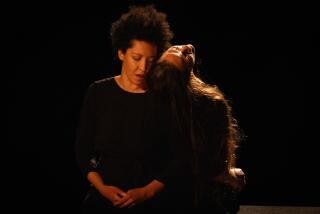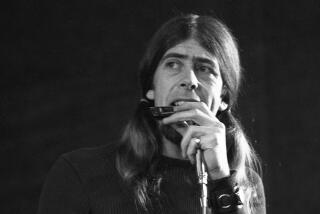The real Diana Krall is liberated on ‘Live in Paris’
Diana Krall’s career has unfolded in such spectacular fashion during the past few years that it’s almost nit-picking to suggest that she might have done anything better or differently. With millions of albums sold, a Grammy nomination for album of the year (almost unheard-of for a jazz artist) and a Grammy Award for best jazz vocal album, she would seem to have accomplished more in a few years than most jazz performers could dream of achieving in a lifetime.
But Krall’s new album, “Live in Paris” (*** 1/2, Verve), raises a few intriguing doubts about her previous albums. Released almost as an afterthought to a DVD/video concert performance, it displays a Krall who was only rarely present in her previous two studio albums, “When I Look in Your Eyes” and “The Look of Love.” Those CDs certainly represent jazz singing at an extremely high level, but their elaborate production and multicolored layers of sound allowed very little room for the spontaneous, brilliantly off-the-cuff vocalizing and solid piano work that make “Live in Paris” such a remarkable release.
Krall’s vocal style has always been idiosyncratic, more comparable to what instrumentalists do with their horns. Occasionally swallowing words, accenting phrases through subtle shifts of vocal timbre, she has gradually transformed these qualities into dramatic devices to emphasize a song’s story without sacrificing an underlying sense of inherent swing. Too often, in her previous two releases, the rough but attractive edges of her vocals were smoothed out, and rhythmic propulsion was occasionally sacrificed in favor of lush, orchestral timbres.
Not so here. Although she sings several tunes from “The Look of Love,” only two are performed with orchestral accompaniment. And it is fascinating to contrast the small ensemble versions performed live and the strings-heavy counterparts on the studio album. Very simply, Krall performs as though she has been liberated, singing with obvious joy, occasionally tossing in a humorous sidebar comment, scatting here and there, and offering great, swinging chunks of the piano work that was so minimized in “The Look of Love.”
It’s not news that Krall’s success has driven record companies to search far and wide for young, white, female jazz vocalists. The results have been, at best, uneven. The most successful of the post-Krall singers has been Norah Jones -- recording for the jazz label Blue Note, but producing an album that is essentially country-oriented. Verve -- Krall’s company -- has also signed Lizz Wright, the rare African American performer in the new wave of singers, but her first album has yet to be released.
Here are recent arrivals delineating the range of material coming down the pipe:
Eden Atwood
“Waves: The Bossa Nova Session”
***, Groove Note
Sweet-voiced Atwood, who has gone through a number of not particularly successful career phases, is particularly well suited for a program ranging from Antonio Carlos Jobim classics to bossa nova renderings of Lennon & McCartney’s “Fool on the Hill” and Irving Berlin’s “How Deep Is the Ocean.” It would have been nice for her to explore a wider range of material.
But what really makes Atwood’s interpretations so appealing is the emotional authenticity she brings to every number.
Tierney Sutton
“Something Cool”
***, Telarc
Los Angeles-based Sutton has been quite visible lately, and with good cause. She has been well served by the opportunity to work with a regular group that includes pianist Christian Jacob, bassist Trey Henry and drummer Ray Brinker. Given that empathic interaction, she ventures through an extraordinarily diverse collection of material: a romping “Route 66,” a new variation on the June Christy-associated “Something Cool,” three tunes from Lerner & Loewe’s “My Fair Lady,” a touching version of Duke Ellington’s “Reflections” and a joyously scat-driven take on Harburg and Arlen’s “Ding-Dong! The Witch Is Dead.”
Wesla Whitfield
“The Best Thing for You Would Be Me: The Irving Berlin Songbook”
***, High Note
If anyone deserves the label “cabaret jazz singer,” it’s Whitfield. Her primary merit is the ability to perfectly articulate both the words and the messages in her material, while delivering her lines with a brisk rhythmic undercurrent. But most of the jazz aspects of her recordings and performances stem from the presence of husband Mike Greensill at the piano. For this outing, he has assembled a somewhat larger ensemble featuring saxophonist Gary Foster and trombonist Marty Wehner to explore a 17-song collection of Berlin classics, most of which are offered with their rarely heard verses.
Meredith d’Ambrosio
“Love Is for the Birds”
** 1/2, Sunnyside
Neither Whitfield nor D’Ambrosio exactly fits the “young” vocalist label, but both have built steady careers by remaining true to their artistic convictions. In D’Ambrosio’s case, that approach results in some thorny but compelling music. All the tracks here are originals -- either written by her, or her lyrics added to existing compositions. The collaborations include Kenny Dorham’s “Rhyme of Spring (Poetic Spring),” Harold Land’s “That Magic Rapture (Rapture)” and Clifford Brown’s “Daahoud.” D’Ambrosio’s calm, almost expressionless voice is an acquired taste, but there’s no denying the adventurous qualities of her songs.
Banu Gibson & Bucky Pizzarelli
“Steppin’ Out”
***, Swing Out Records
Terry Blaine
“Lonesome Swallow”
***, Jukebox Jazz
Gibson and Blaine are well-established interpreters of the music of the ‘20s and ‘30s, approaching numbers such as “Steppin’ Out With My Baby,” “Put the Blame on Mame,” “Am I Blue” and “Jeepers Creepers” with great stylistic accuracy. That said, there’s nothing musty or worn about either performance.
Blaine, on her fifth recorded project with pianist Mark Shane, has loads of fun with Andy Razaf double-entendre numbers such as “My Handy Man” before shifting into the easygoing lyricism of “100 Years From Today.”
Gibson has a bit more of a contemporary quality to her readings, and one of the album’s many appealing aspects is her jaunty interaction with guitarist Pizzarelli.
Keely Smith
“Keely Swings Basie-Style”
** 1/2, Concord Records
Smith was never really a jazz artist, even in her salad years of the ‘50s when she worked side by side with husband Louis Prima. But her deadpan delivery and focused melodic lines worked well in the quasi-jazz settings of the decade’s lounge music. Starting up her career again recently, she has made a series of recordings that are essentially revivalist interpretations. Unlike Gibson and Blaine, however, Smith’s renderings do sound a bit musty, despite the strong backup from an orchestra of L.A. studio all-stars. That probably won’t matter for lounge fans, of course, but others may have problems with Smith’s monochromatic style, as well as the disconcerting Southern-belle accent with which she delivers phrases such as the opening line of “You Go to My Head.”
*
Albums are rated on a scale of one star (poor), two stars (fair), three stars (good) and four stars (excellent).
More to Read
The biggest entertainment stories
Get our big stories about Hollywood, film, television, music, arts, culture and more right in your inbox as soon as they publish.
You may occasionally receive promotional content from the Los Angeles Times.










